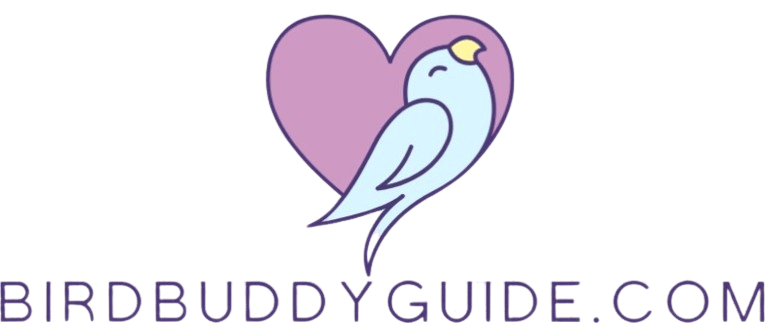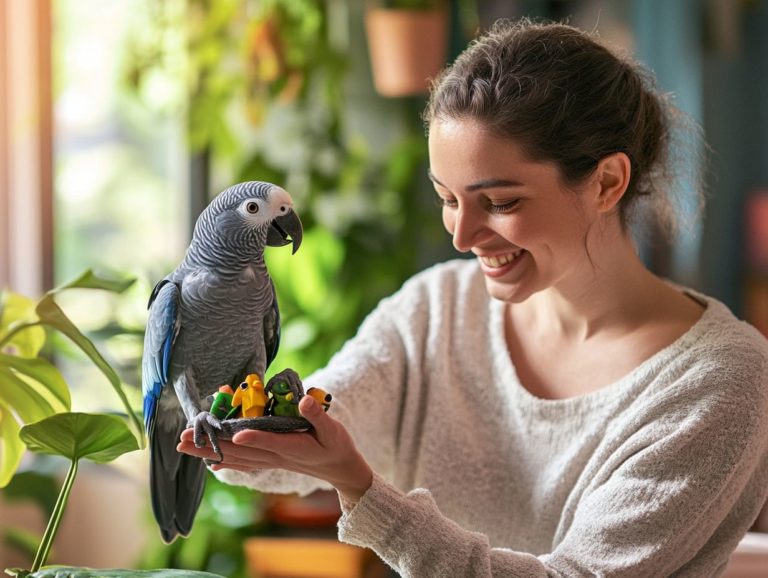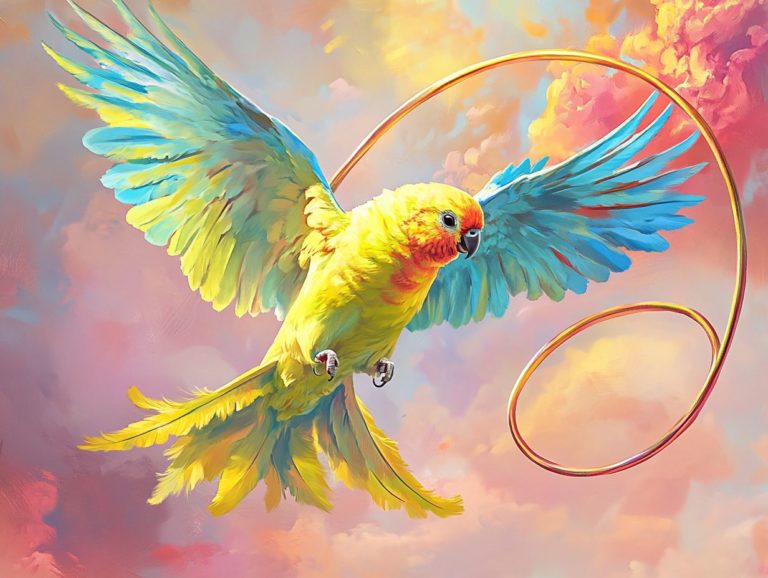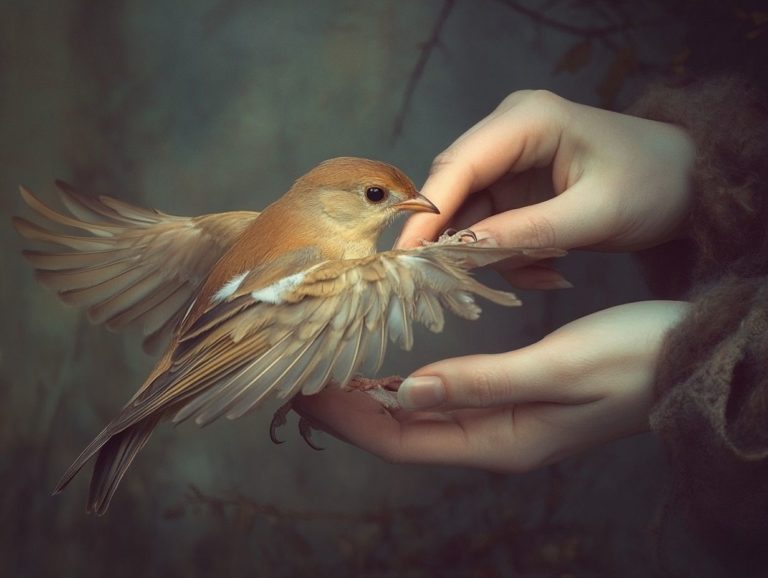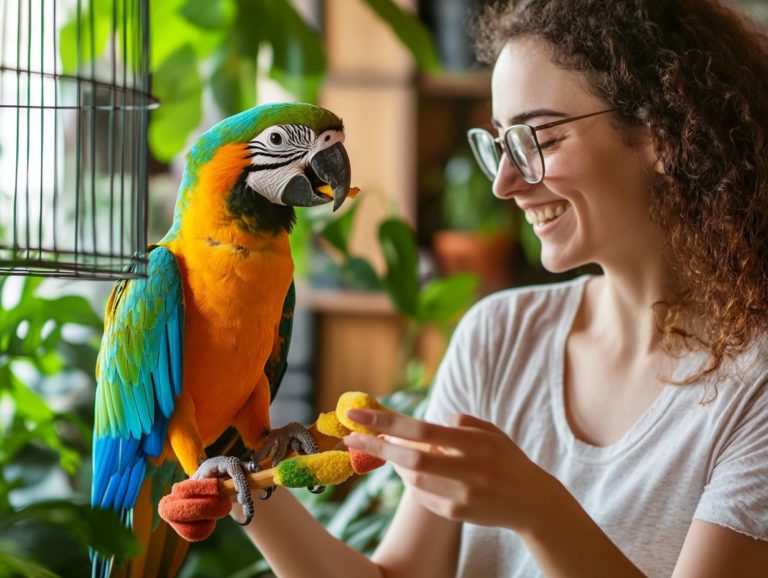How to Train Your Bird to Stay Calm
Training your pet bird to remain calm is crucial for their well-being and your peace of mind. By understanding the common triggers of stress and anxiety in birds, you can cultivate a supportive environment that promotes tranquility.
This guide offers effective training tools and techniques to establish trust. You will discover exciting strategies that will enhance your bird’s training journey!
With the right approach, you can nurture a happy, calm companion who enriches your life.
Contents
- Key Takeaways:
- Understanding Your Bird’s Behavior
- Tools for Training Your Bird
- Step-by-Step Training Process
- Maintaining a Calm Environment
- Handling Unexpected Stressful Situations
- Continuing Training and Progress Tracking
- Frequently Asked Questions
- What is the best way to train my bird to stay calm?
- Can any type of bird be trained to stay calm?
- How can I create a calm environment for my bird?
- What should I do if my bird becomes agitated during training?
- Are there any specific techniques I should use to train my bird to stay calm?
- How long does it typically take to train a bird to stay calm?
Key Takeaways:
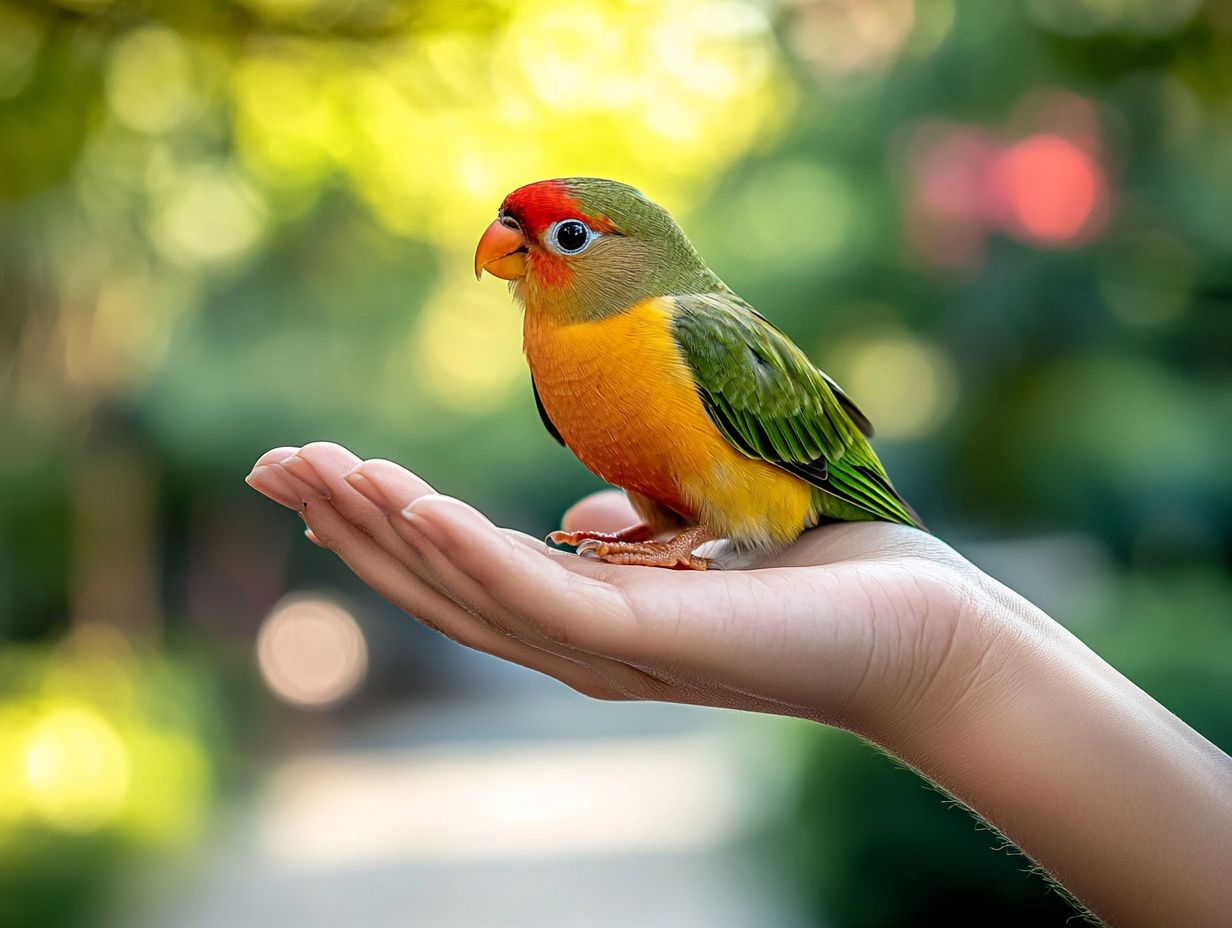
- Learn to understand your bird’s behavior and common triggers for stress and anxiety to effectively train them to stay calm.
- Use recommended training supplies and follow a step-by-step process to establish trust and teach calming techniques.
- Maintain a peaceful living space and develop strategies for managing unexpected stressful situations to continue training and track progress with consistency.
Understanding Your Bird’s Behavior
Grasping your bird’s behavior is fundamental for effective training. Cultivating a trusting relationship with your avian companion is essential.
Birds display a wide range of behaviors that reflect their emotional state. It s crucial for you, as a pet bird owner, to understand these nuances for harmonious interaction.
By recognizing signs of discomfort, you can create a serene environment where trust flourishes. This will ultimately strengthen your bond with a diverse array of species, from parakeets and cockatiels to macaws and African greys.
Common Triggers for Stress and Anxiety
Common triggers for stress and anxiety in your pet birds include changes in their environment, unexpected loud noises, or unfamiliar people approaching their cage too quickly.
Pay close attention to your bird’s reactions. Recognizing signs of discomfort is crucial for their well-being!
Various environmental factors can intensify signs of discomfort in your avian companions. For instance, sudden shifts in temperature or humidity can leave a bird feeling vulnerable or agitated.
The presence of predatory animals, like cats or dogs nearby, can increase anxiety levels as these birds instinctively sense danger. Bright lights or chaotic household activities can amplify their discomfort, leading to behaviors such as feather plucking, excessive vocalization, or withdrawal from social interactions.
Recognizing these triggers is essential for creating a safe and calming space for your sensitive feathered friends.
Tools for Training Your Bird
The right tools are crucial for your bird training success. They allow you to employ techniques that emphasize positive reinforcement while effectively teaching commands.
A range of tools can significantly enrich your training experience, from clickers to treat-dispensing devices. Each is designed to reward desired behaviors in a timely manner.
By mastering the use of these tools, you can create a productive environment for your avian companions, whether you re working with parakeets, cockatoos, or macaws.
Recommended Training Supplies
Recommended training supplies for enriching your bird’s learning experience include high-quality treats, clickers, and specialized training books that detail effective techniques for various bird species.
These essential tools streamline the training process and create a delightful atmosphere for both you and your feathered friend.
High-quality treats serve as powerful motivators, enhancing your bird’s experience while reinforcing the behaviors you want to encourage.
Clickers function as precise markers. They signal to your bird when it has executed a desired action, facilitating clear communication about your expectations.
Training books offer valuable insights into species-specific behaviors and allow you to tailor your strategies for improved interaction. Together, these supplies can significantly elevate the effectiveness of your training journey.
Start training your bird now for a happier pet!
Step-by-Step Training Process
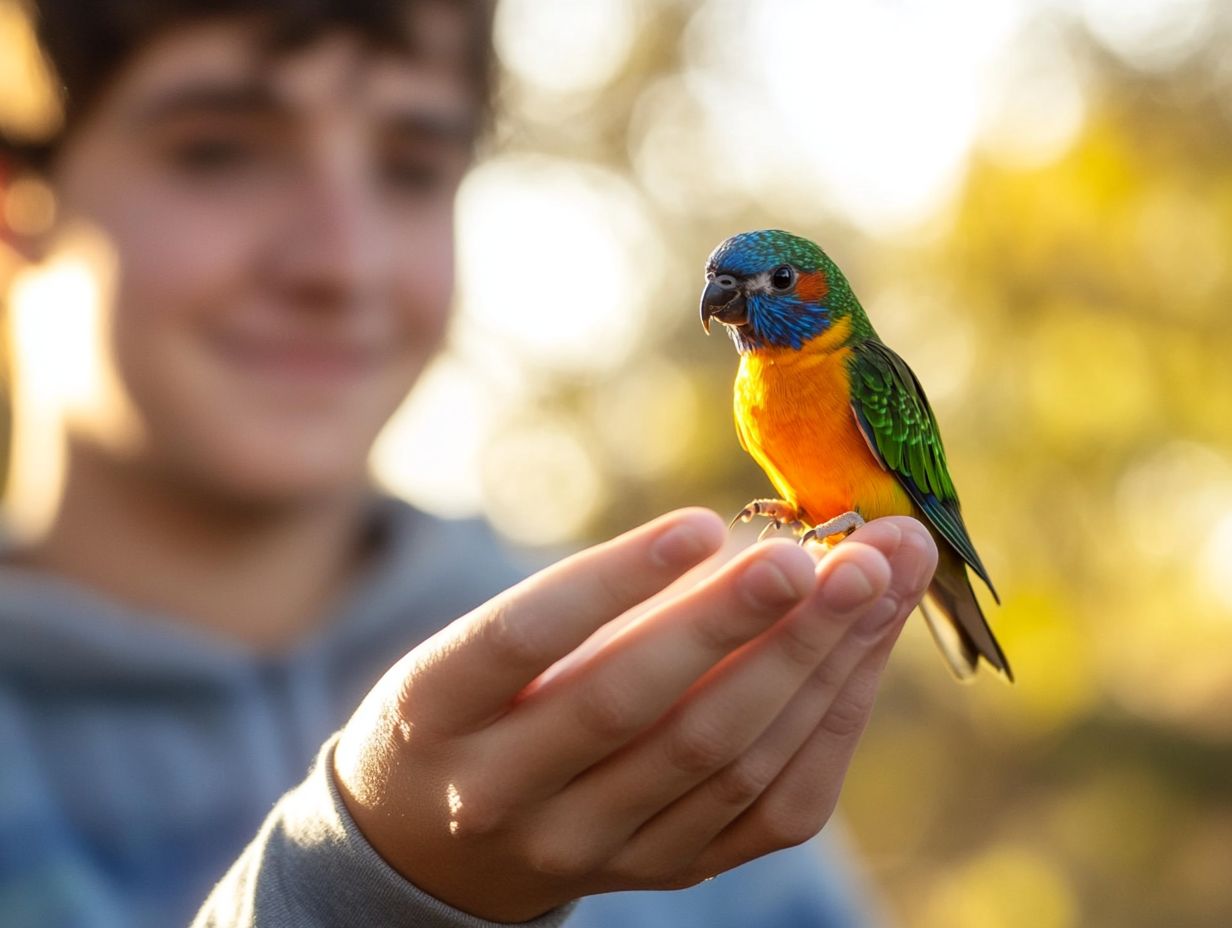
The step-by-step training process for pet birds requires you to embrace positive reinforcement techniques that build trust and deepen the bond between you and your bird.
Training demands patience as you gradually introduce commands. Ensure your bird feels comfortable every step of the way. This method works for a range of bird species, including cockatiels, conures, and African greys, creating an enjoyable training experience.
Establishing Trust and Positive Reinforcement
Establishing trust through positive reinforcement is essential for effectively training your pet bird and nurturing a lasting bond based on comfort and understanding.
This process requires you to consistently recognize desired behaviors with rewards think treats, praise, or playtime. For example, when your bird successfully completes a trick or responds to a cue, reinforcing that behavior with a small treat encourages repetition and instills a sense of security. This builds a nurturing environment where your bird can thrive!
Over time, your bird will learn to associate training sessions with positive outcomes. This allows trust to flourish, transforming your bird into a more engaged and responsive companion. By adopting positive reinforcement techniques, you can make training a joyful and rewarding experience for both you and your bird.
Teaching Calming Techniques
Teaching calming techniques to your bird is vital for reducing stress and creating a comfortable environment that encourages positive behavior.
Incorporate gentle vocalizations, soft music, or designated quiet areas during training sessions to lower anxiety levels and help your bird feel at ease. Keep an eye out for warning signs like pacing, feather plucking, or excessive vocalization; these indicate your bird may feel overwhelmed and could benefit from calming techniques.
When your avian companion shows signs of discomfort, apply these strategies to foster a more peaceful atmosphere. This ultimately leads to improved interactions and a deeper bond between you and your bird.
Maintaining a Calm Environment
Maintaining a serene environment is essential for bird ownership, as it profoundly influences your bird’s well-being and behavior. A tranquil living space can alleviate stress and anxiety in various species, from canaries to cockatoos.
By incorporating natural elements, choosing ergonomic cages, and minimizing disturbances, you can create a sanctuary where your bird feels secure and comfortable.
Creating a Peaceful Living Space
Creating a tranquil living space for your pet bird requires thoughtful attention to details such as cage placement, fun activities, and minimizing disturbances to enhance their comfort and security.
Selecting the right spot for your bird’s cage is essential. It should be placed away from drafts and harsh sunlight, ideally at eye level. This lets your bird interact with you comfortably.
Incorporating a range of toys boosts mental stimulation and keeps boredom at bay, enabling your bird to express natural behaviors.
To further cultivate this serene environment, minimize noise and interruptions. Soft furnishings can absorb sound, and establishing boundaries such as a quiet zone around your bird s space promotes relaxation and overall well-being. How can you create a calm space for your bird?
Handling Unexpected Stressful Situations
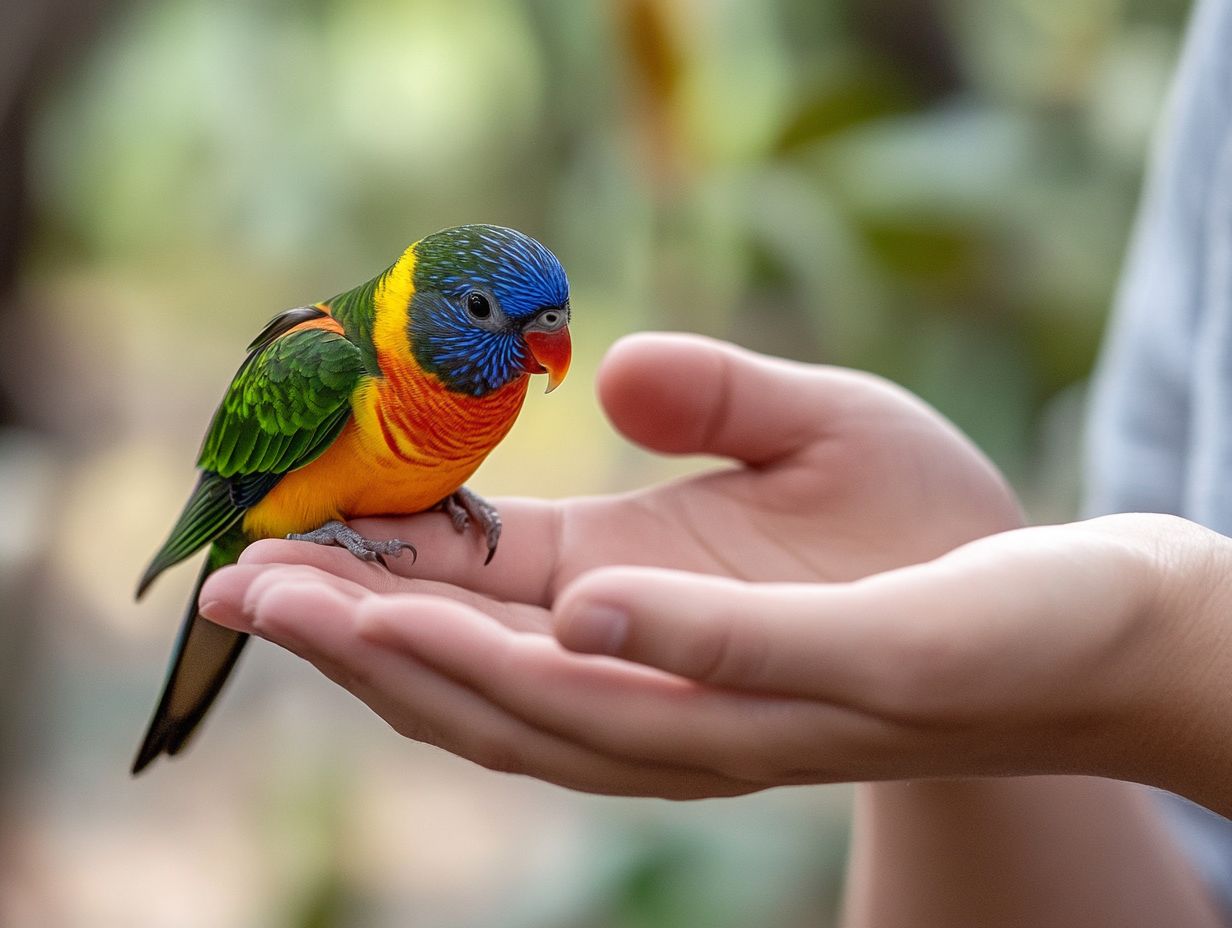
Managing unexpected stressful situations with your bird calls for effective strategies that prioritize their well-being and help them calm down swiftly. Birds are sensitive to sudden changes or disturbances, so it s crucial to be equipped with techniques to manage their behavior.
By leveraging your understanding of avian behavior, you can respond effectively, ensuring your bird feels secure and comfortable in their environment.
Strategies for Managing Stressful Events
Strategies for managing stressful events in your bird’s life may include gradually exposing them to new experiences and conducting consistent training sessions that reinforce their comfort and security.
By adopting a slow approach to getting your bird used to new experiences, you can establish a more predictable environment, which significantly helps in alleviating anxiety. Familiarizing your bird with their surroundings through repeated exploration will bolster their confidence over time.
Engaging in calming rituals, such as gentle handling or quiet playtime, nurtures a profound sense of safety. Maintaining a regular routine that incorporates feeding and interaction times is also helpful, as this predictability can further soothe their stress response.
As changes inevitably arise, ensuring consistent training and rewarding good behavior will cultivate resilience, enabling your bird to navigate life’s unexpected twists with greater ease.
Continuing Training and Progress Tracking
Ongoing training and progress tracking are essential for ensuring that your bird retains learned commands and nurtures a trusting relationship with you as their owner. Regular practice reinforces techniques, while meticulously tracking their progress allows you to pinpoint areas needing extra attention or adjustments in your training approach.
This is particularly crucial for various bird species, such as African greys, macaws, and finches.
Tips for Consistency and Tracking Progress
To ensure consistency in bird training, establish a regular schedule, use the same commands, and make sure rewards are given promptly to reinforce desired behaviors.
Implementing a structured approach can significantly enhance the effectiveness of your training sessions. Dedicating specific time slots each day helps form a routine and sets clear expectations for your bird.
Utilizing a consistent set of commands fosters familiarity, allowing your bird to better understand and respond. Regularly monitoring progress whether through notes or a training journal provides valuable insights into which methods resonate best, enabling you to make necessary adjustments.
Varying the types of rewards while maintaining timely delivery keeps your bird engaged and motivated, ultimately reinforcing positive behaviors more effectively.
Frequently Asked Questions
What is the best way to train my bird to stay calm?
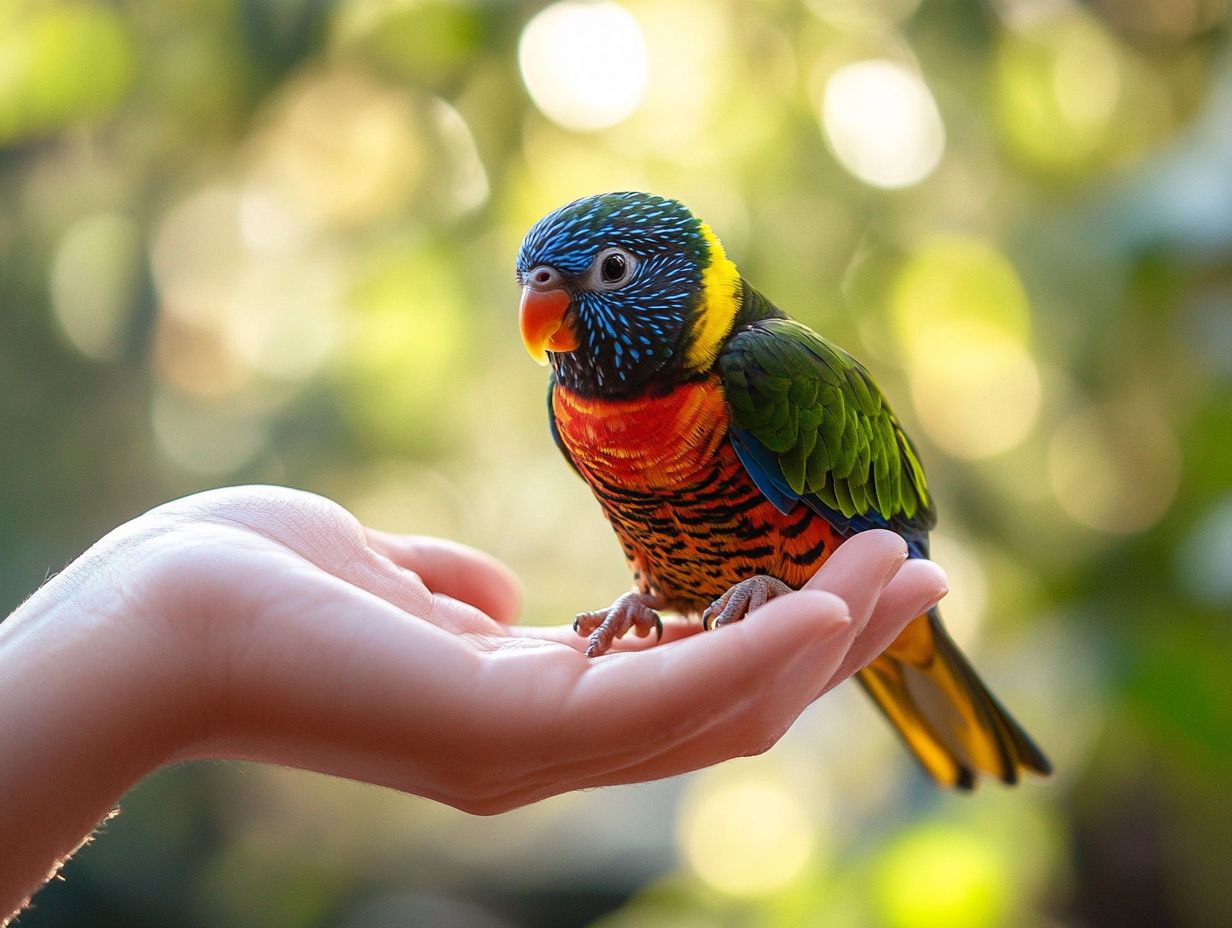
The best way to train your bird to stay calm is to start with short training sessions and gradually increase the duration. For more effective methods, consider these tips for training a timid bird using positive reinforcement techniques such as treats and praise to reward calm behavior and avoid using punishment.
Can any type of bird be trained to stay calm?
Yes, most birds can be trained to stay calm with patience and consistency. However, some species may be naturally more high-strung than others, so it may take more time and effort to train them.
How can I create a calm environment for my bird?
Make sure your bird’s cage is placed in a quiet area of your home and avoid sudden loud noises. Provide your bird with toys and activities to keep them mentally stimulated, and use calming scents such as lavender or chamomile in the room.
What should I do if my bird becomes agitated during training?
If your bird becomes agitated, take a break and try again later. It’s important not to force your bird to continue training if they feel stressed or anxious. Remember to always use positive reinforcement and never punish your bird.
Are there any specific techniques I should use to train my bird to stay calm?
One effective technique is to teach your bird a “calm” or “relax” command. Start by saying the command in a calm tone and rewarding your bird when they exhibit calm behavior. For more techniques, consider these tips for teaching birds to be confident. Gradually increase the duration of calm behavior before giving the reward.
How long does it typically take to train a bird to stay calm?
The time it takes to train a bird to stay calm can vary depending on the individual bird’s personality and the consistency of training. Some birds may learn quickly while others may take several weeks or even months. The key is to be patient and stay consistent with training.
Remember to apply these training tips regularly and don’t hesitate to seek further assistance if needed!
